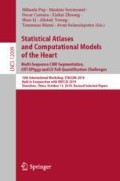Abstract
Accurate left ventricular (LV) segmentation in cardiac MRI facilitates quantification of clinical parameters such as LV volume and ejection fraction (EF). We present a CNN-based method to obtain a 3D representation of LV by integrating information from 2D short-axis and horizontal and vertical long-axis images. Our CNN is flexible to the number of input slices and uses an additional input of image coordinates as spatial context. This concept is validated on variations of two well-known CNN architectures for medical image segmentation: U-Net and DeepMedic. Five-fold cross validation on a dataset of 20 patients achieved a correlation of 95.0/93.1\(\%\) for quantification of end-diastolic volume, 91.6/90.8\(\%\) for end-systolic volume and 80.5/84.5\(\%\) for EF for the two architectures respectively. We show that (1) incorporating long-axis data improves segmentation performance and (2) providing spatial context by adding image coordinates as input to the CNN yields similar performance with a smaller receptive field.
Access this chapter
Tax calculation will be finalised at checkout
Purchases are for personal use only
References
Bernard, O., et al.: Deep learning techniques for automatic MRI cardiac multi-structures segmentation and diagnosis: is the problem solved? IEEE Trans. Med. Imaging 37(11), 2514–2525 (2018)
Zheng, Q., et al.: 3D consistent & robust segmentation of cardiac images by deep learning with spatial propagation. IEEE Trans. Med. Imaging 37(9), 2137–2148 (2018)
Poudel, R.P.K., Lamata, P., Montana, G.: Recurrent fully convolutional neural networks for multi-slice MRI cardiac segmentation. In: Zuluaga, M.A., Bhatia, K., Kainz, B., Moghari, M.H., Pace, D.F. (eds.) RAMBO/HVSMR -2016. LNCS, vol. 10129, pp. 83–94. Springer, Cham (2017). https://doi.org/10.1007/978-3-319-52280-7_8
Duan, J., et al.: Automatic 3D bi-ventricular segmentation of cardiac images by a shape-refined multi-task deep learning approach. IEEE Trans. Med. Imaging 38(9), 2151–2164 (2019)
Zotti, C., et al.: Convolutional neural network with shape prior applied to cardiac MRI segmentation. IEEE J. Biomed. Health Inform. 23(3), 1119–1128 (2019)
Oktay, O., et al.: Anatomically constrained neural networks (ACNNs): application to cardiac image enhancement and segmentation. IEEE Trans. Med. Imaging 37(2), 384–395 (2018)
Wang, C., Smedby, Ö.: Automatic whole heart segmentation using deep learning and shape context. In: Pop, M., et al. (eds.) STACOM 2017. LNCS, vol. 10663, pp. 242–249. Springer, Cham (2018). https://doi.org/10.1007/978-3-319-75541-0_26
Oktay, O., et al.: Multi-input cardiac image super-resolution using convolutional neural networks. In: Ourselin, S., Joskowicz, L., Sabuncu, M.R., Unal, G., Wells, W. (eds.) MICCAI 2016. LNCS, vol. 9902, pp. 246–254. Springer, Cham (2016). https://doi.org/10.1007/978-3-319-46726-9_29
Luo, G., et al.: Multi-views fusion CNN for left ventricular volumes estimation on cardiac MR images. IEEE Trans. Biomed. Eng. 65(9), 1924–1934 (2018)
Kaggle, Booz Allen Hamilton Inc.: Second Annual Data Science Bowl Kaggle (2015). https://www.kaggle.com/c/second-annual-data-science-bowl
Wachinger, C., et al.: DeepNAT: deep convolutional neural network for segmenting neuroanatomy. NeuroImage 170, 434–445 (2018)
Elen, A., Hermans, J., Ganame, J., et al.: Automatic 3-D breath-hold related motion correction of dynamic multisclice MRI. IEEE Trans. Med. Imaging 29(3), 868–878 (2010)
Ronneberger, O., Fischer, P., Brox, T.: U-net: convolutional networks for biomedical image segmentation. In: Navab, N., Hornegger, J., Wells, W.M., Frangi, A.F. (eds.) MICCAI 2015. LNCS, vol. 9351, pp. 234–241. Springer, Cham (2015). https://doi.org/10.1007/978-3-319-24574-4_28
Kamnitsas, K., et al.: Efficient multi-scale 3D CNN with fully connected CRF for accurate brain lesion segmentation. Med. Image Anal. 36, 61–78 (2017)
Ioffe, S., Szegedy, C.: Batch normalization: accelerating deep network training by reducing internal covariate shift. In: ICML (2015)
Maas, A.L., et al.: Rectifier nonlinearities improve neural network acoustic models. In: ICML (2013)
He, K., et al.: Delving deep into rectifiers: surpassing human-level performance on ImageNet classification. In: ICCV 2015, pp. 1026–1034 (2015)
Acknowledgement
Sofie Tilborghs is supported by a Ph.D. fellowship of the Research Foundation - Flanders (FWO).
Author information
Authors and Affiliations
Corresponding author
Editor information
Editors and Affiliations
Rights and permissions
Copyright information
© 2020 Springer Nature Switzerland AG
About this paper
Cite this paper
Tilborghs, S., Dresselears, T., Claus, P., Bogaert, J., Maes, F. (2020). 3D Left Ventricular Segmentation from 2D Cardiac MR Images Using Spatial Context. In: Pop, M., et al. Statistical Atlases and Computational Models of the Heart. Multi-Sequence CMR Segmentation, CRT-EPiggy and LV Full Quantification Challenges. STACOM 2019. Lecture Notes in Computer Science(), vol 12009. Springer, Cham. https://doi.org/10.1007/978-3-030-39074-7_10
Download citation
DOI: https://doi.org/10.1007/978-3-030-39074-7_10
Published:
Publisher Name: Springer, Cham
Print ISBN: 978-3-030-39073-0
Online ISBN: 978-3-030-39074-7
eBook Packages: Computer ScienceComputer Science (R0)


